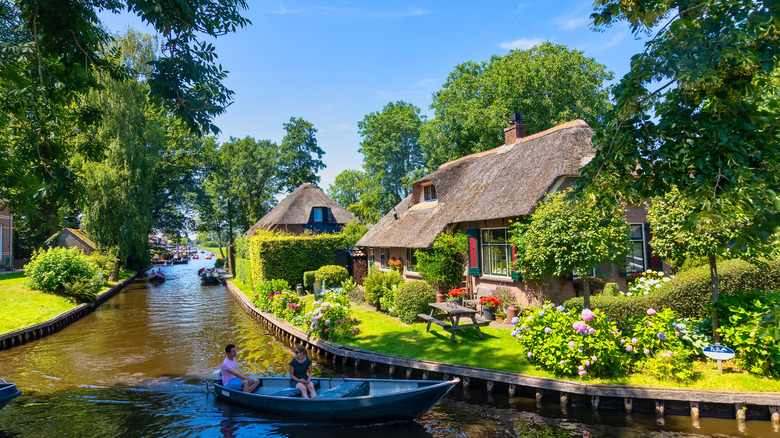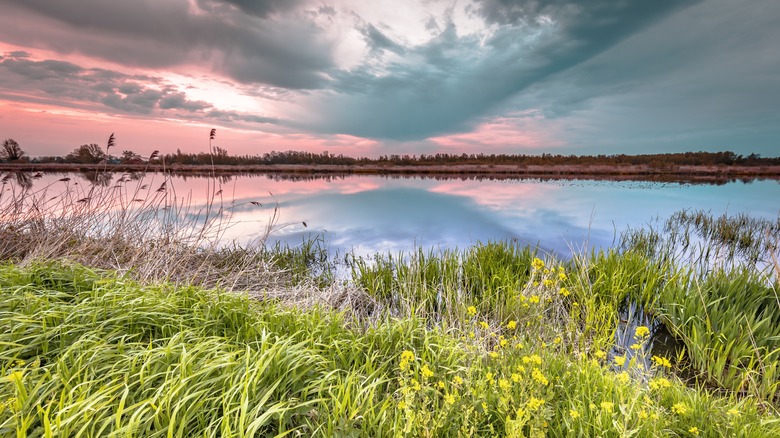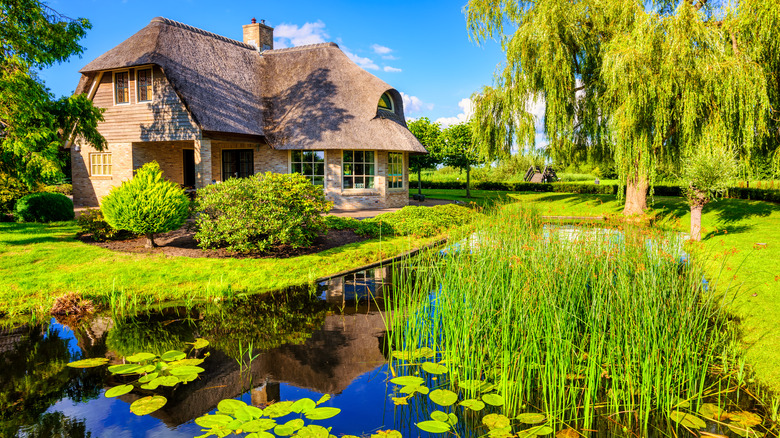Why You Should Never Expect To See Any Cars In The Center Of The Dutch Village Of Giethoorn
For those city dwellers in the crowd, try tipping your ear to the air and getting a sense of exactly how noisy your environment is: Cars whishing by in the streets, maybe people yelling, and the bustle of urban life loudly ringing in all directions. For those elsewhere, you've got noise, too. This may be the ubiquitous hum of a refrigerator, maybe a helicopter or truck passing by, the regular creaks and groans of a house. So imagine if you will a pastoral village of greenery and quaint canals that looks so peaceful and is so silent that you'd dread breaking the perfection. Oh, and the big thing about this place? There are no cars allowed.
Such is Giethoorn (literally translated as "goat horn"), a 3,000-person hamlet situated in the Dutch countryside far from the hustle and bustle of Amsterdam, as well as Europe's busiest trade port, Rotterdam, or anything else, really. Situated in the provincial region of Overijssel less than an hour west of the German border by car, Giethoorn is comprised of walking paths, tiny canals, thatch-roofed homes, islands composed of peat, and private gondolas that people presumably push around while calling out a friendly salutation to their smiling and waving neighbors (per National Geographic). Basically, it's like Venice stripped of its grandiosity, and remixed with an Edenic paradise.
And the funny thing about Giethoorn? It was founded by a group of "fugitives from the Mediterranean" some 800 years ago (per Atlas Obscura). Seems like they did a pretty decent job of building utopia.
Refuge for outlaws, mercenaries, and monks
Even without the beautiful, shire-like homes of modern Giethoorn, it's pretty easy to see why some folks fleeing from authorities might have stopped in the region, taken a look around, and said, "Yeah, you know what? This'll do." We don't have any details, but Atlas Obscura states that the original settlers in the area were "outlaws," "mercenaries," and "fugitives" who took root around 1230 C.E. By all accounts, a group of monks, though, dug the canals sometime later in order to transport peat through the region. The official Giethoorn Village website states that the canals were dug by hand.
The peat dug out of the area's marshlands was also used to construct the very islands that compose Giethoorn, and upon which its lovely little houses, pathways, bridges, and so forth, were built. At present, there are 176 walking and biking paths through the village and over its four miles of canals without even a single road for cars. That is to say that there are no modern streets in the original, ultra-green area of the town, which as we can see on Google Maps, resides southwest of a downtown-ish, shop-filled town called Steenwijk. Reason being, in a very practical sense, the original peat islands can't support the weight nor the wear and tear. Besides which, the locals voted to leave the Giethoorn unaltered. Now visitors can poke around town in honest-to-goodness gondolas and breathe some fresh, quiet, unpolluted air.
Punting around in a whisper boat
For those intending to visit Giethoorn in either the recent or far-flung future, you're in luck. Trains can take you there from many cities in Europe. Or if you drive, you can roll up as close as possible, find parking, and hail a "punter" boat. As the Giethoorn Village website states, this kind of traditional boat dates back to the 16th and 17th centuries. Because the canals of Giethoorn are very shallow but also level with the ground, punters used to be pushed around using long poles, like gondolas in Venice. Many of these, for those interested in rentals, are now motorized whisper boats.
As for things to do besides meander around and admire the beauty, the area is a lush wetland full of wildlife and hiking paths and is home to the largest fen in northwestern Europe, Weerribben-Wieden (via the Netherlands official tourism site). And tourists interested in marijuana, take note: The Giethoorn Village website clearly says that the nearest "coffeeshop" (the Dutch nickname for marijuana shops) is in Steenwijk to the northeast.
As for Giethoorn's name, we've got to look back to a semi-mythologized tale related to the village's founding. National Geographic reports that those who settled in the area discovered a whole bunch of goat horns there that may have been related to a flood that hit in 1170. The original name, "Geytenhoren," apparently was shortened to "Giethoorn" over time, and voila. Now we've got the name that's lasted through the present.


